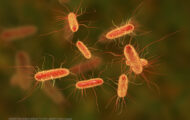NSF International, which was founded from the University of Michigan’s School of Public Health as the National Sanitation Foundation to standardize sanitation and food safety requirements 66 years ago, has released its 2013 Germ Study and names the 10 utensils and appliances in the kitchen that harbor pathogenic bacteria. The study analyzed 14 common kitchen items for the presence of E. coli, Salmonella, yeast and mold, and Listeria.
 The six “germiest” items were: the refrigerator vegetable compartment, which harbored Salmonella, Listeria, yeast and mold; the refrigerator meat compartment, which had Salmonella, E. coli, yeast and mold; blender gaskets and can openers, which had Salmonella, E. coli, yeast and mold; rubber spatulas, which had E. coli, yeast, and mold; and food storage containers with rubber seals, which harbored Salmonella, yeast and mold. Other problematic items included the refrigerator water dispenser, refrigerator ice dispenser, and knife blocks. These appliances and tools come into direct contact with food, especially raw produce and ready to eat foods. And consumers aren’t cleaning these items properly to eliminate these pathogens.
The six “germiest” items were: the refrigerator vegetable compartment, which harbored Salmonella, Listeria, yeast and mold; the refrigerator meat compartment, which had Salmonella, E. coli, yeast and mold; blender gaskets and can openers, which had Salmonella, E. coli, yeast and mold; rubber spatulas, which had E. coli, yeast, and mold; and food storage containers with rubber seals, which harbored Salmonella, yeast and mold. Other problematic items included the refrigerator water dispenser, refrigerator ice dispenser, and knife blocks. These appliances and tools come into direct contact with food, especially raw produce and ready to eat foods. And consumers aren’t cleaning these items properly to eliminate these pathogens.
Food Poisoning Bulletin talked to Lisa Yakas, project manager in NSF’s Home Product Certification Program about this study. She said that the organization is “not trying to scare people, but trying to make people aware of the problems that can occur in the kitchen.” She continued, “education is the key, and if people stop and think about their households, the most susceptible groups are the very young, the elderly, pregnant women, and immune-compromised people. If anyone in those groups is in your home, we’re trying to make you aware so you can better protect yourself. More than 20% of foodborne illness outbreaks originate from food consumed in the home.”
NSF has provided a Safer Home Fact Kit, with tips to clean each of these problematic appliances and utensils. The organization recommends using soap, water, mild detergents, and baking soda solutions to clean. It’s important to take items, such as blenders and two piece rubber spatulas, apart to thoroughly clean gaskets and nooks and crannies where bacteria can hide. Using the dishwasher is the best way to sanitize small items.




